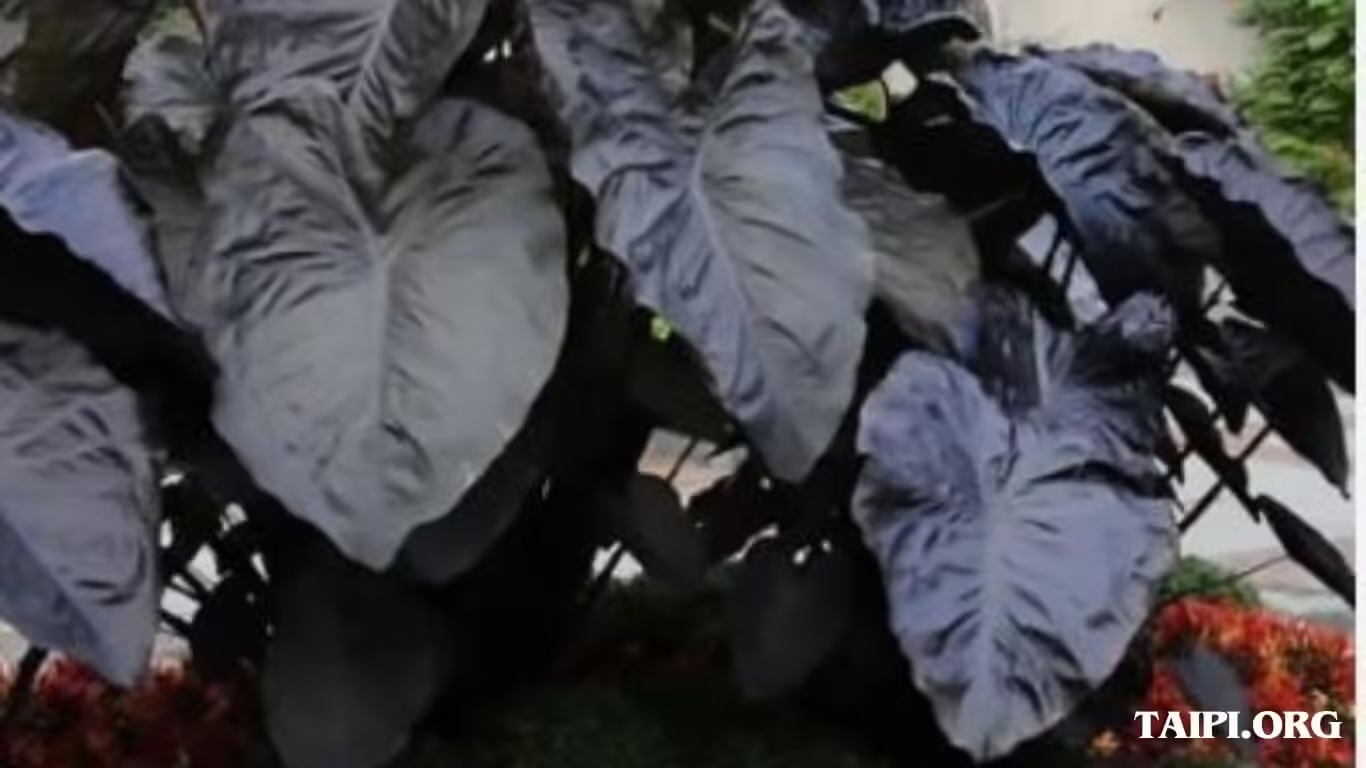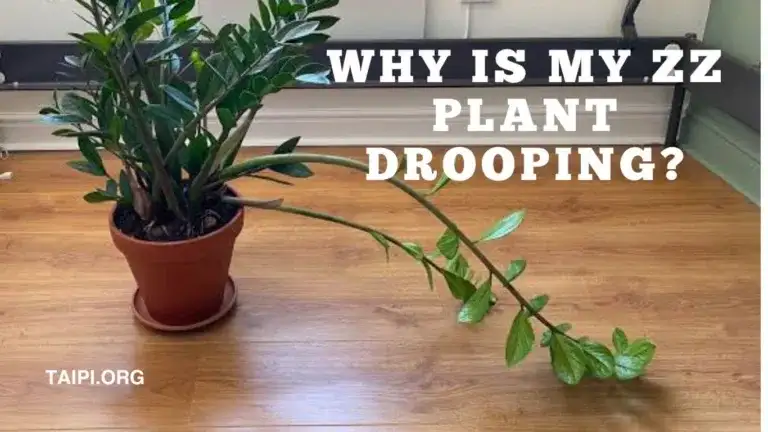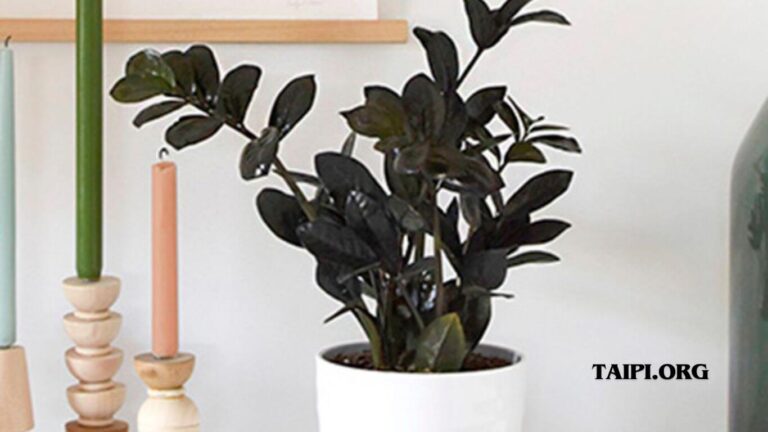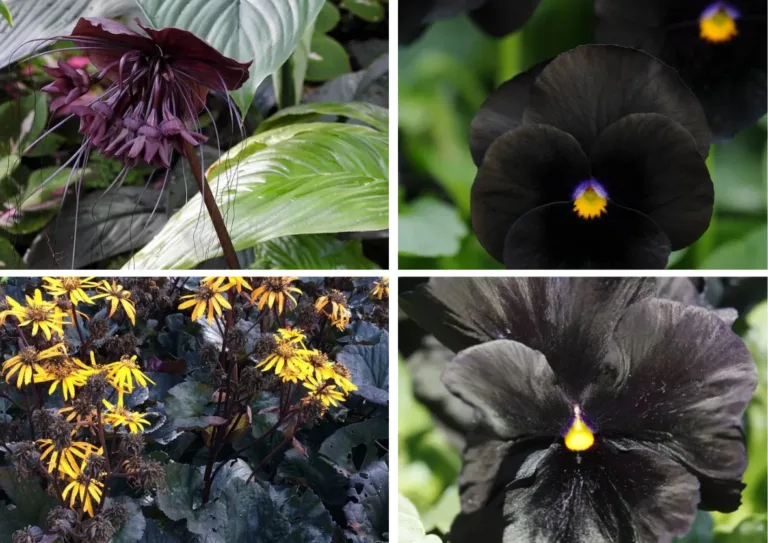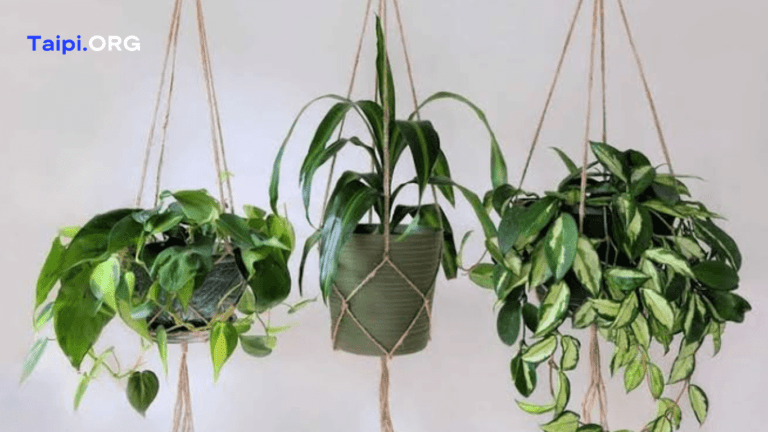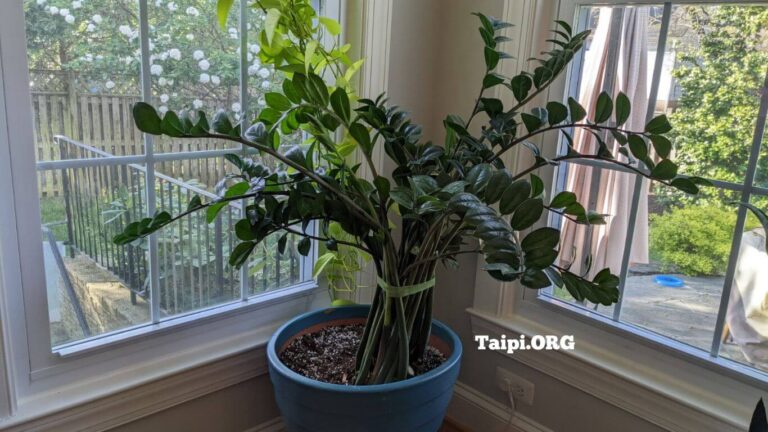28 Black Houseplants You Never Knew Existed
“WHY would I even think of a black houseplant, let alone spending a dime on it?” But wait!
In the dimly lit corners of your home, black houseplants can cast an intriguing spell, captivating beholders with their deep, velvety hues and unique forms.
From the elegant Black Prince to the whimsical Black Bat Flower, each black plant in this curated selection adds a touch of drama and sophistication to indoor spaces, transforming them into verdant sanctuaries of intrigue and beauty.
Also read: Why Are Houseplant Leaves Turning Black?
So, before you dismiss the thought of welcoming black stems and leaves into your interior space, here is a list of 28 black houseplants you should consider:
You should know that these plants vary in size, shape, and care requirements, so be sure to choose ones that fit your space and level of gardening expertise.
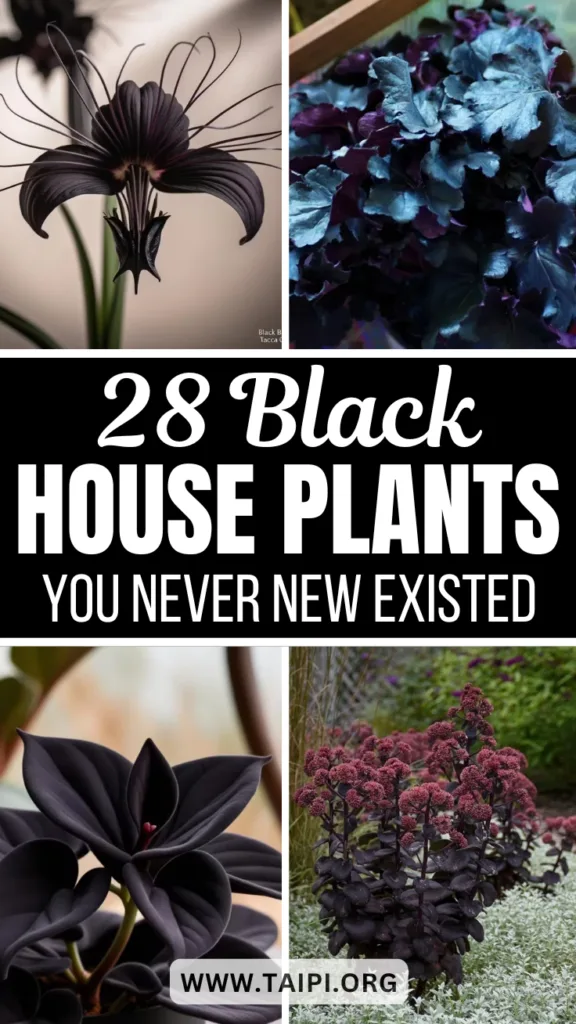
Now, here is a detailed care explanation of each of the fifteen black houseplants that no one told you about:
1. Black Pearl Ornamental Pepper
 Source: Kerry Michaels
Source: Kerry MichaelsWith its glossy, jet-black foliage and striking red fruit, the Black Pearl Ornamental Pepper stands out as a living statement piece. The deep purple leaves shimmer in the light, while the bright red peppers provide a stark color contrast.
You’ll love growing it in outdoor beds or indoor pots for its bold texture and color combination. It’s the plant you need to give your garden or home personality.
Plus, those peppers are edible—perfect for adding a little drama to your kitchen as well.
2. Velvet Charm of Black Pearl Coral Bells
 Source: Melanie Dawn Harter / Getty Images
Source: Melanie Dawn Harter / Getty ImagesBlack Pearl Coral Bells flaunt their intriguing dark foliage, almost resembling crushed velvet. Their rich, moody tones are a perfect match for shaded garden areas or as low-maintenance potted plants.
The leaves, with hints of purple, add dimension and depth to your floral arrangements. Whether placed indoors or outdoors, this plant creates a striking foundation for any plant display.
It’s the kind of understated elegance that quietly transforms the energy of a space.
3. Dramatic Leaves of Philodendron Royal Queen
 Source: Jamaludin Yusup / Getty Images
Source: Jamaludin Yusup / Getty ImagesThe Philodendron Royal Queen commands attention with its glossy, dark purple-to-black leaves. This low-maintenance houseplant adds an elegant, moody vibe to indoor spaces.
Place it on a corner table or as a floor plant to fill a room with life and movement. Besides looking stunning, it’s an easy-care option for plant lovers of all experience levels.
4. Twilight Magic’ Crape Myrtle
 Source: FirstEditionsPlants.com
Source: FirstEditionsPlants.comWith dark reddish-purple leaves and bright pink blooms, the Twilight Magic Crape Myrtle truly stands out. Its rich foliage makes it a top option for anyone designing a vibrant garden.
The smooth contrast between the flowers and leaves keeps things interesting without overpowering the space.
Whether used as an ornamental shrub or a centerpiece, this plant embodies simple drama.
5. Black Bat Begonia (Begonia darthvaderiana)
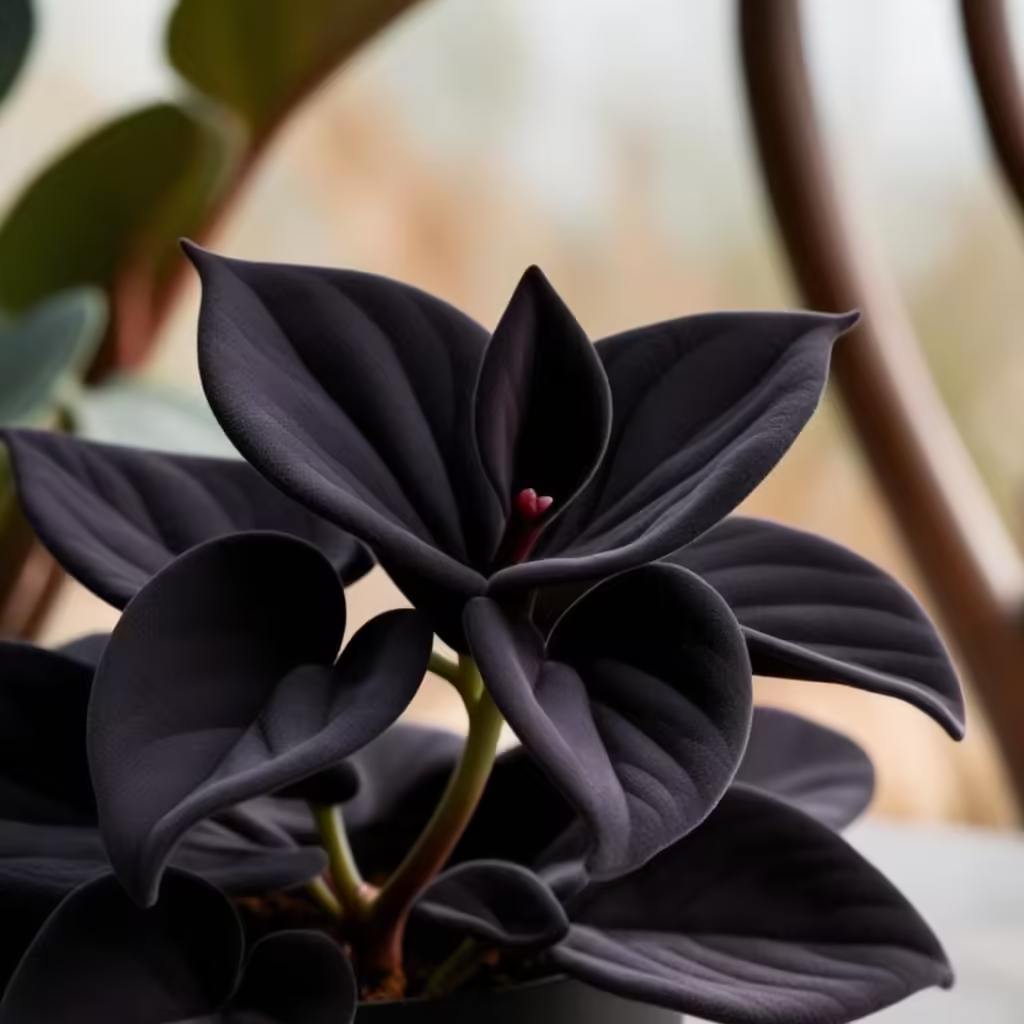
The Black Bat Begonia is a captivating species revered for its unique foliage, which resembles the wings of a bat. Native to Malaysia, this exotic plant thrives in bright, indirect light and well-draining soil with high organic content.
Keep the soil consistently moist but not waterlogged, as Begonias are susceptible to root rot. Fertilize the Black Bat Begonia monthly during the growing season with a balanced liquid fertilizer diluted to half-strength to promote lush foliage and abundant flowering.
Regular grooming, including removing dead or yellowing leaves, will help maintain the plant’s overall health and aesthetic appeal.
6. Black Magic’ Mangave
 Source: Perennial Resource.com
Source: Perennial Resource.comThe pointy, textured leaves of the Black Magic Mangave look both edgy and serene.
Their dark, almost black hue makes this exotic succulent a great pick for modern indoor settings or rock gardens. It thrives with minimal care and will instantly update the look of any space.
Use it as a standalone centerpiece or mix it into a container garden with other succulents.
7. Black Velvet Elephant Ear (Colocasia esculenta ‘Black Magic’)
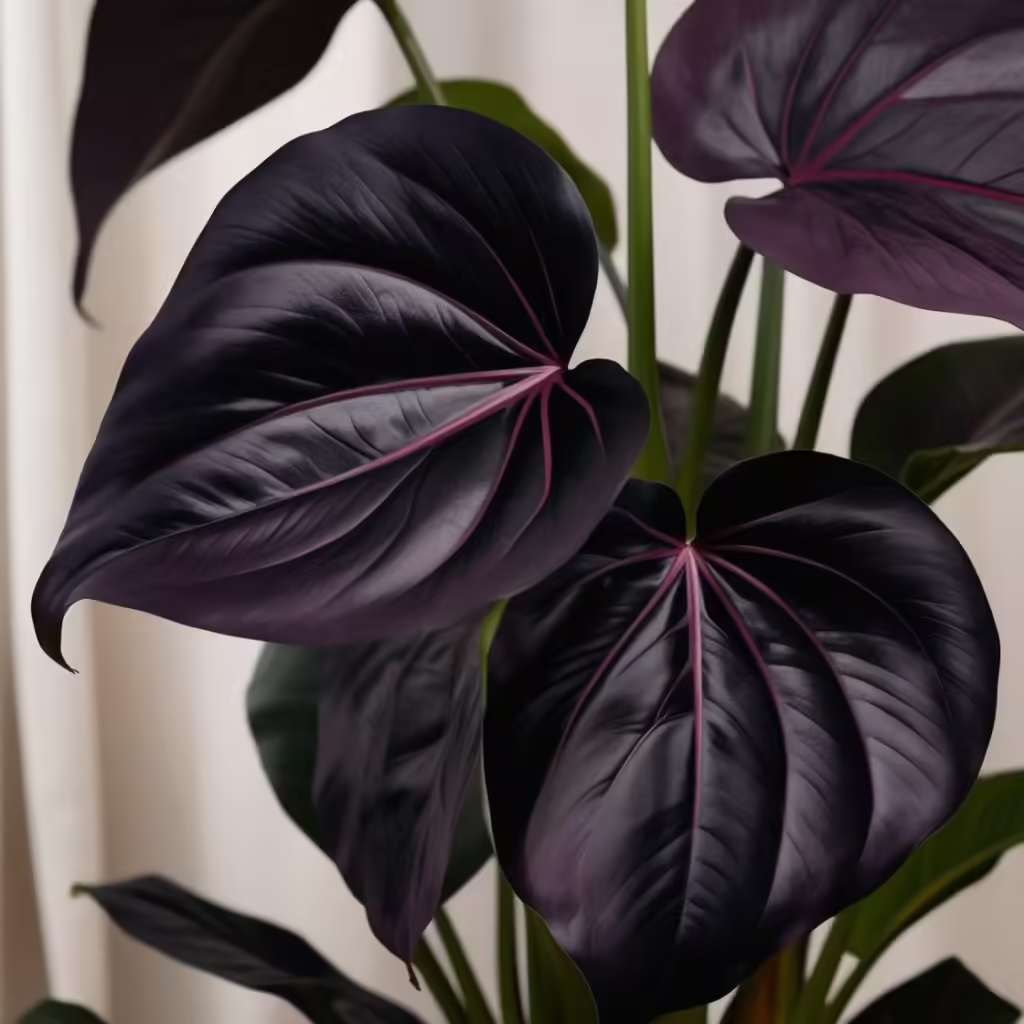
The Black Velvet Elephant Ear is a striking cultivar esteemed for its large, heart-shaped leaves with velvety, jet-black foliage. This black houseplant is Native to Southeast Asia, and thrives in partial shade to full sun and consistently moist, well-draining soil.
Water regularly to keep the soil evenly moist, especially during the active growing season. Fertilize the Black Velvet Elephant Ear bi-weekly with a balanced liquid fertilizer diluted to half-strength to provide essential nutrients for healthy growth and vibrant foliage coloration.
Mulching around the base of the plant will help retain soil moisture and suppress weed growth.
8. Black Parrot Tulip
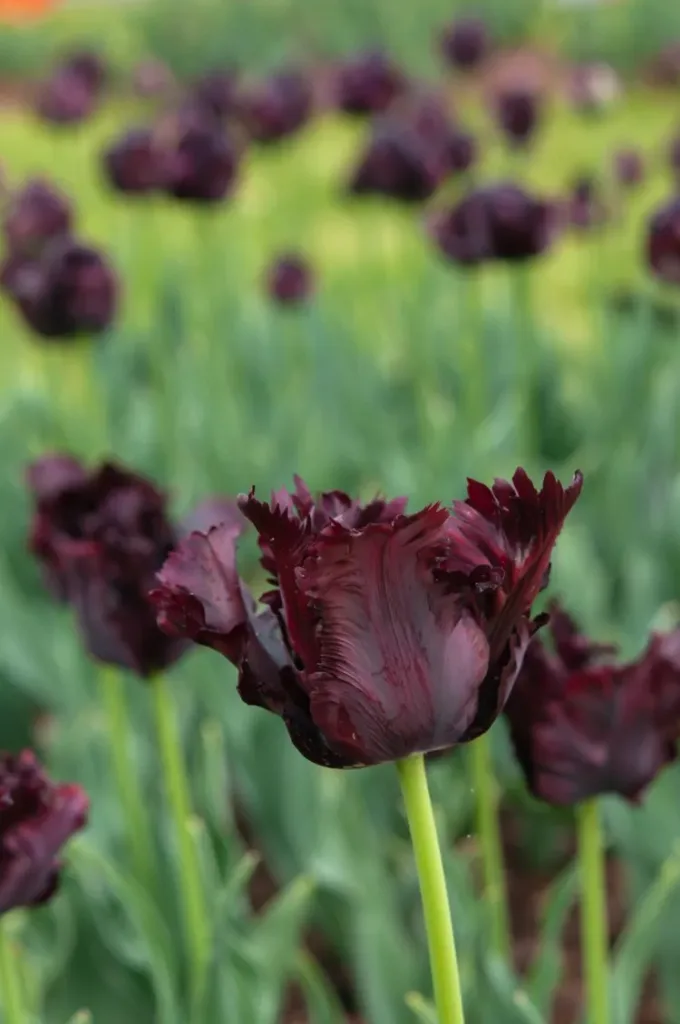 Source: Evgeniya Vlasova
Source: Evgeniya VlasovaThis bold tulip is a real showstopper. With ruffled, feather-like petals in shades of dark maroon to black, the Black Parrot Tulip looks luxurious in any spring garden.
Its textured petals add an intriguing touch that’s hard to forget. Plant these tulips along garden paths or in combination with lighter flowers to make their dramatic color pop even more.
Plus, they’re great as cut flowers for vase displays.
9. Black ZZ Plant (Zamioculcas zamiifolia ‘Raven’)
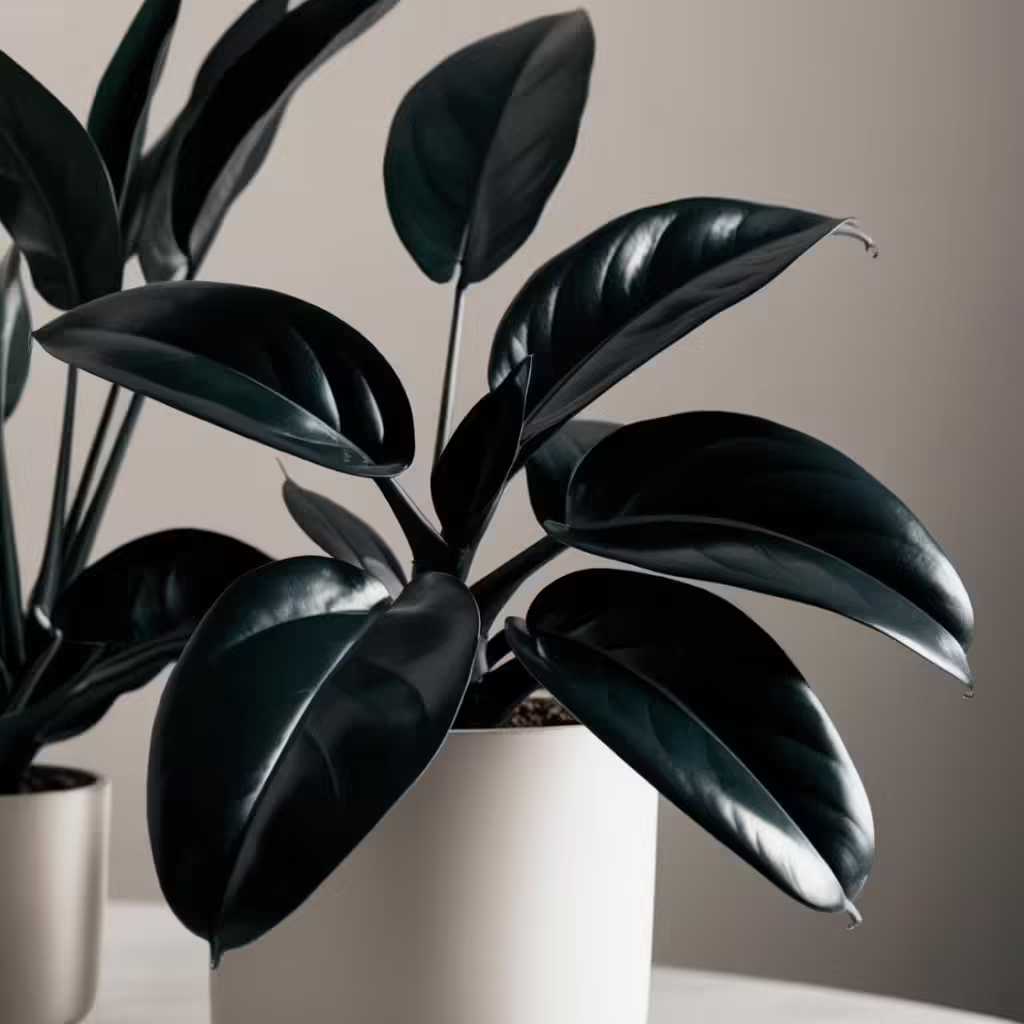
With its glossy, ebony leaves held aloft on slender stems, the Black ZZ Plant adds a touch of sophistication to any indoor space. This resilient plant, native to Eastern Africa, is renowned for its tolerance of neglect and low-light conditions.
The Black ZZ Plant thrives in indirect light but can adapt to brighter conditions as well. Water sparingly, allowing the soil to dry out between waterings to prevent root rot.
During the growing season, fertilize the Black ZZ Plant bi-monthly with a diluted, balanced liquid fertilizer to provide essential nutrients for healthy growth.
Avoid over-fertilizing, as this can lead to excessive foliage growth at the expense of overall plant health.
10. The Striking Leaves of Black Sweet Potato Vine
 Source: David J. Stang, CC BY-SA 4.0 / Wikimedia Commons
Source: David J. Stang, CC BY-SA 4.0 / Wikimedia CommonsThe Black Sweet Potato Vine is loved for its heart-shaped, dark purple to almost black leaves.
Whether crawling along the ground or cascading down a pot, these vines add depth to gardens and patios.
Pair them with brightly colored flowers to let their dark tones shine. If you’re designing a space that’s rich in contrast, these eye-catching leaves make a lush addition.
11. Black Rose (Aeonium arboreum ‘Schwarzkopf’)
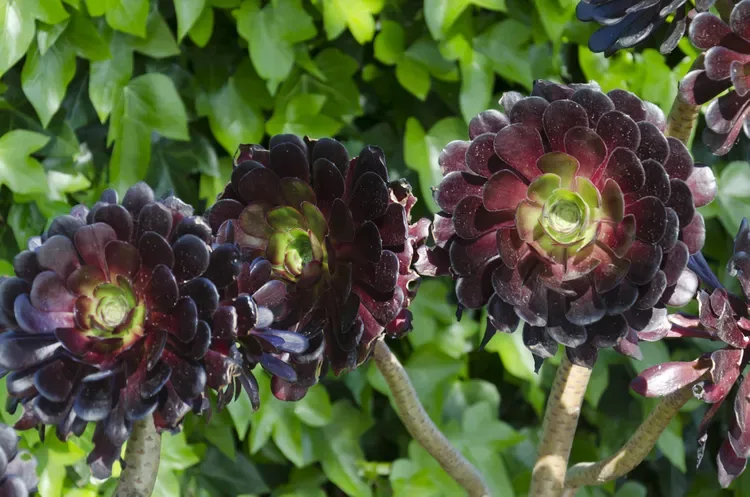
The Black Rose is a captivating succulent thanks to its rosettes of deep burgundy-black leaves, forming a striking contrast against its green stems.
Native to the Canary Islands, this drought-tolerant plant thrives in bright, indirect light and well-draining soil. Allow the soil to dry out between waterings, especially during the dormant winter months, to prevent root rot.
To grow a healthy Black Rose, fertilize this black houseplant sparingly with a balanced liquid fertilizer every two to three months during the active growing season to provide essential nutrients for healthy growth and vibrant foliage coloration.
Pruning back leggy growth and removing spent rosettes will help maintain the plant’s compact, bushy appearance and encourage new growth from the base.
12. Unique Elegance of Black Adder
 Source: Saxon Holt/Sunset Plant Collection
Source: Saxon Holt/Sunset Plant CollectionTall and vibrant, the Black Adder plant features striking dark green leaves with hints of blackish-purple.
Its sleek, architectural appearance makes it a wonderful choice for modern garden designs or pots on patios. Pair it with greenery or other dark-hued plants to create a cohesive, themed space.
This low-maintenance plant is ideal for those looking for an exotic and tall centerpiece.
13. Black Bat Flower (Tacca chantrieri)
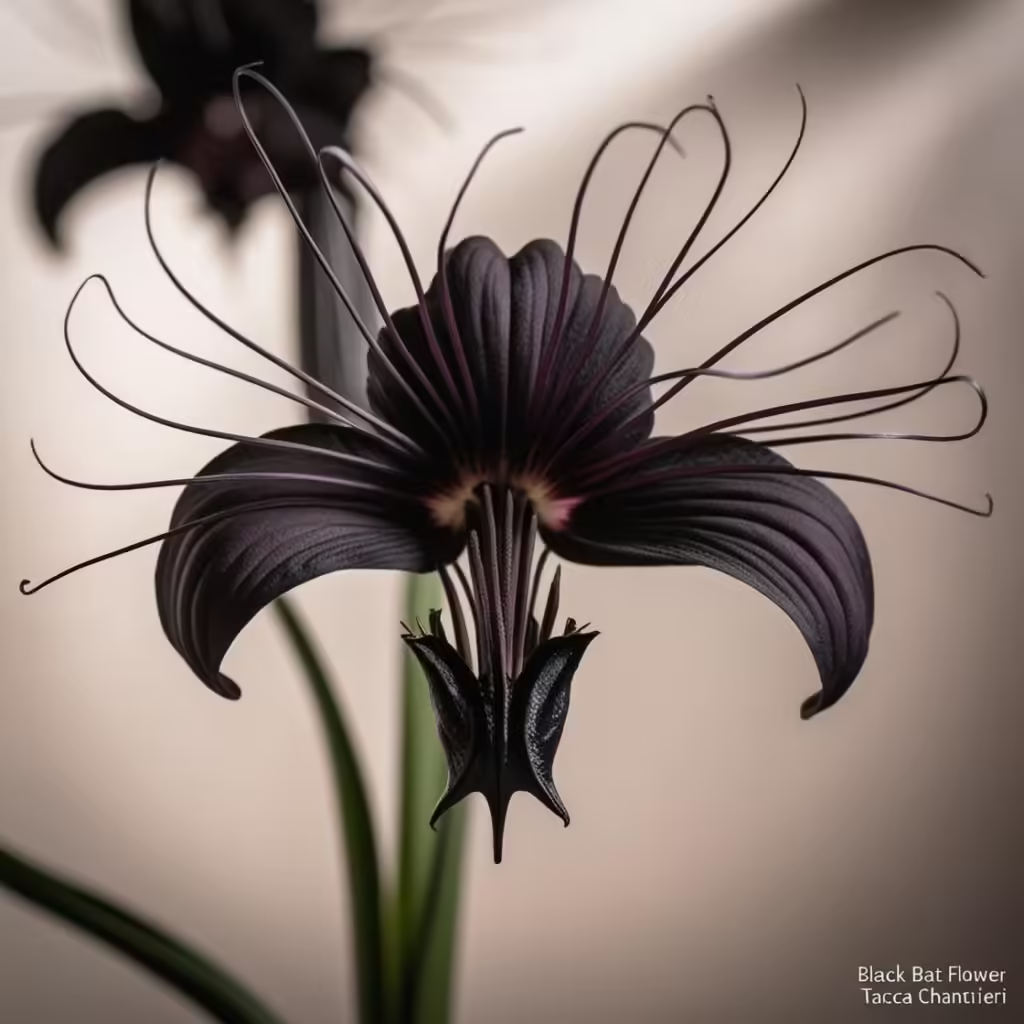
With its mysterious, bat-like bracts surrounding dark purple-black flowers, the Black Bat Flower adds an element of intrigue to any botanical collection.
Native to tropical regions of Southeast Asia, this exotic plant thrives in warm, humid environments with filtered light and well-draining soil.
Adequate air circulation is essential to prevent fungal diseases, so avoid crowding the plant with other foliage. To encourage prolific blooming, fertilize the Black Bat Flower monthly during the growing season with a balanced liquid fertilizer.
Additionally, deadheading spent flowers and providing regular grooming will help maintain the plant’s aesthetic appeal and promote continuous flowering throughout the growing season.
14. Midnight Magic with ‘Midnight Gold’ Double Petunia
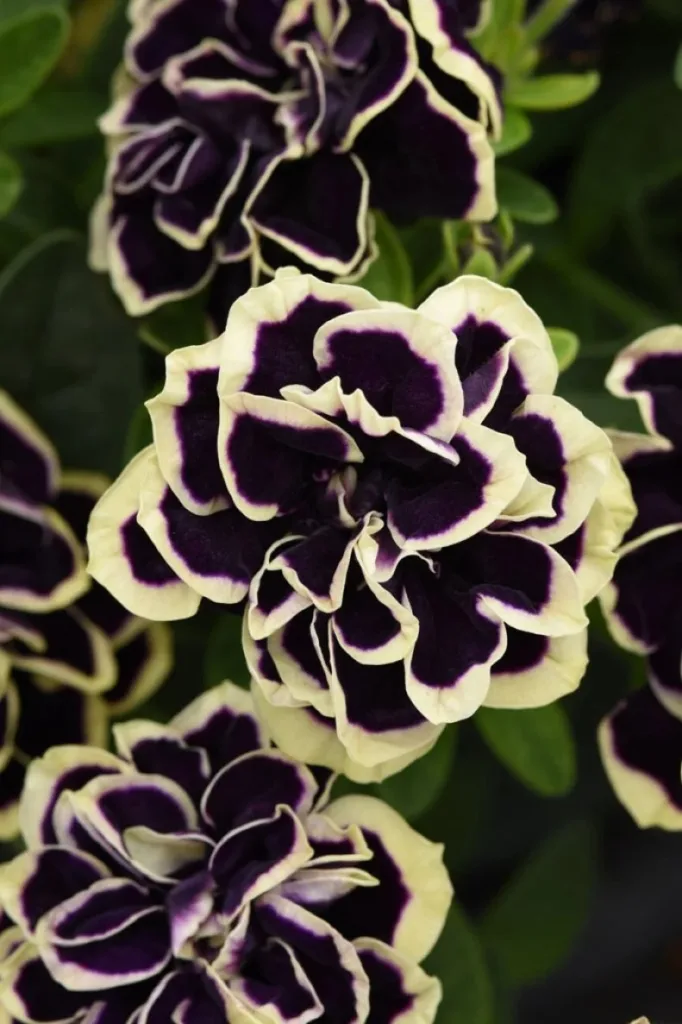 Source: Ball Horticultural
Source: Ball HorticulturalThe lush double blooms of the Midnight Gold Petunia are unlike any other flower.
Sporting velvety deep purple petals with creamy golden edges, this plant brings elegance to garden beds, pots, or hanging baskets. It’s also a great conversation starter for visitors.
Pair it with lighter petunias for a classic floral mix, or let it stand alone for a dramatic monochrome look.
15. Patio Baby’ Eggplant
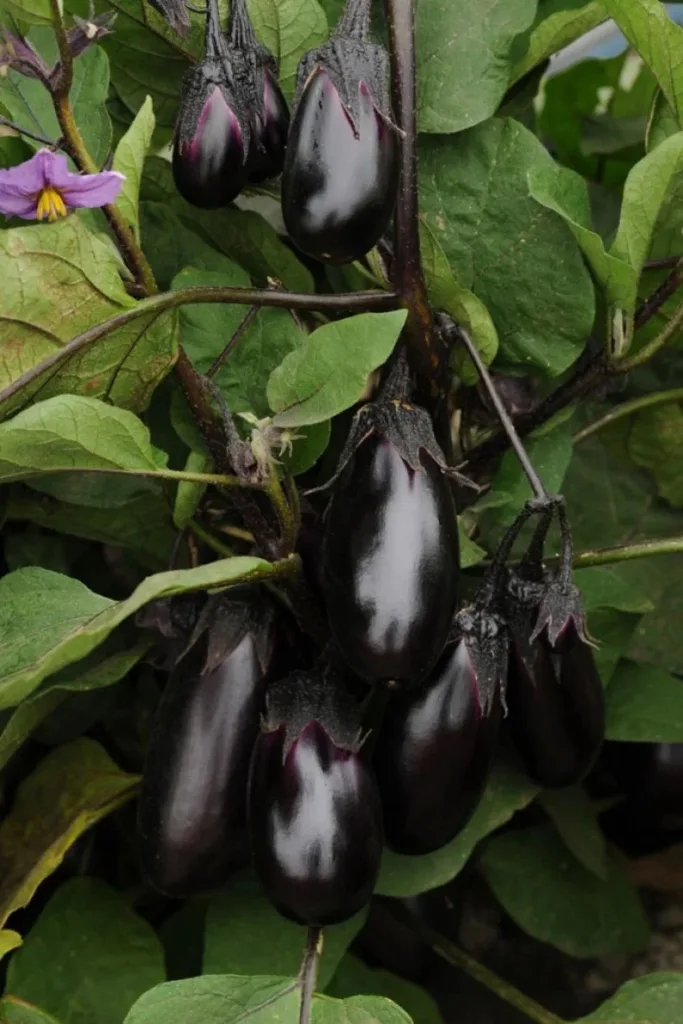 Source: Ball Horticultural
Source: Ball HorticulturalCompact and fruitful, the Patio Baby Eggplant is ideal for black plant enthusiasts who also appreciate edible gardening.
Its shiny, dark purple fruits set against vibrant green foliage provide a dynamic play of textures. Harvesting them is just as satisfying as watching them grow.
This versatile plant is perfect for balconies or small outdoor gardens.
16. Striking Vibes of ‘SolarPower’ Black Heart Ipomoea
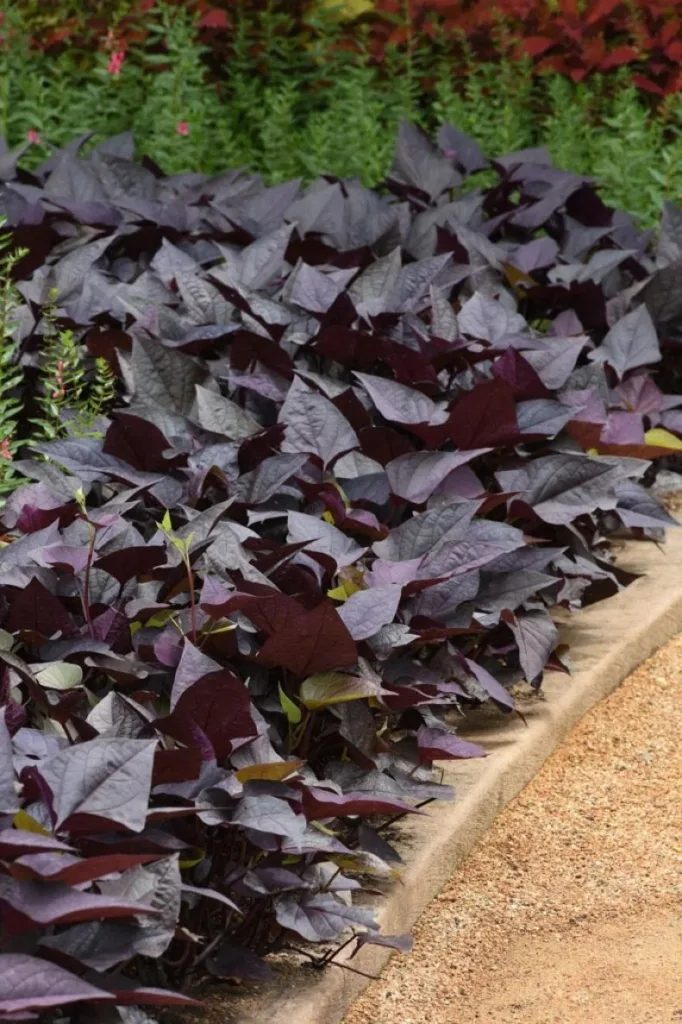 Source: Ball Horticultural
Source: Ball HorticulturalThis sweet potato vine variety boasts beautiful heart-shaped leaves with deep, almost black tones.
It cascades beautifully in planters or sprawls in low-growing garden beds. Its dark aesthetic helps contrast vibrant floral displays or pale backgrounds.
Whether you’re creating a tropical vibe or something minimalist, this vine is a subtle yet striking choice.
17. Night Embers’ Sedum
 Source: Perennial Resource.com
Source: Perennial Resource.comThe Night Embers Sedum adds a rich, earthy tone to gardens with its dark burgundy leaves and vibrant rosy flowers.
Its upright stems make for great fillers in floral beds, while its muted colors provide harmony when paired with silvery or green plants.
This is a fuss-free perennial that’s perfect for layering in garden borders or adding texture to container displays.
18. Low-Maintenance Sophistication with Haworthia
 Source: NooUma / Getty Images
Source: NooUma / Getty ImagesHaworthias, with their spiky cylindrical leaves in shades of dark green and black, are tiny but mighty when it comes to indoor plants.
Their intricate patterns give off a sculptural vibe, which fits a minimalist or modern aesthetic.
Grow them on a desk or window sill with bright, indirect sunlight, and they’ll keep impressing with their long-lasting appeal.
19. Black Prince (Aeonium arboreum ‘Zwartkop’)
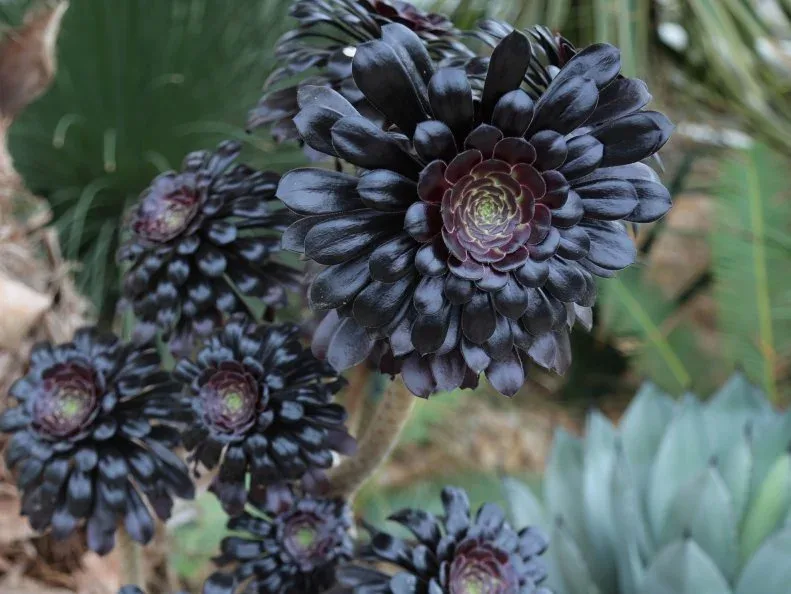
With its rosettes of deep burgundy-black leaves delicately offset by a crown of lime-green, the Black Prince stands as a regal centerpiece in any collection.
This succulent, native to the Canary Islands, thrives in bright, indirect light and well-draining soil. Its compact growth habit makes it ideal for both indoor containers and outdoor gardens in frost-free climates.
During the growing season, which typically spans spring through fall, feed the Black Prince monthly with a balanced fertilizer diluted to half-strength.
This feeding regimen supports robust growth and vibrant foliage coloration, ensuring the plant maintains its striking appearance year-round.
20. Black Velvet Alocasia (Alocasia reginula)
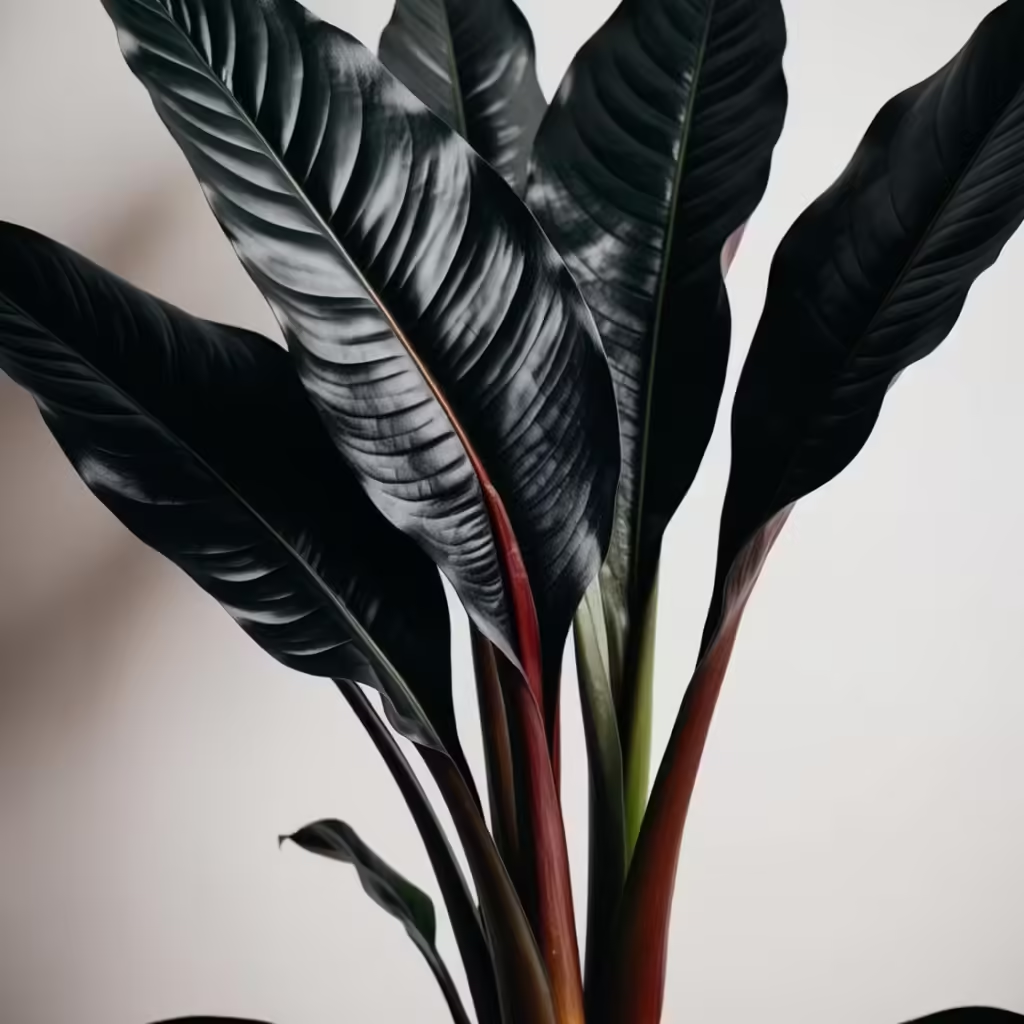
The Black Velvet Alocasia boasts velvety, heart-shaped leaves with striking silver veins, creating a mesmerizing contrast against its dark foliage.
Native to Southeast Asia, this tropical beauty thrives in medium to bright, indirect light and prefers consistently moist soil.
Regular watering is essential to prevent the soil from drying out, especially during the active growing season.
Fertilize the Black Velvet Alocasia bi-weekly with a diluted, balanced liquid fertilizer to provide essential nutrients for healthy growth and to promote lush foliage.
Proper humidity levels are also crucial for this plant’s well-being, making it an excellent candidate for placement in bathrooms or near humidifiers.
21. Black Coral Snake Plant (Sansevieria trifasciata ‘Black Coral’)
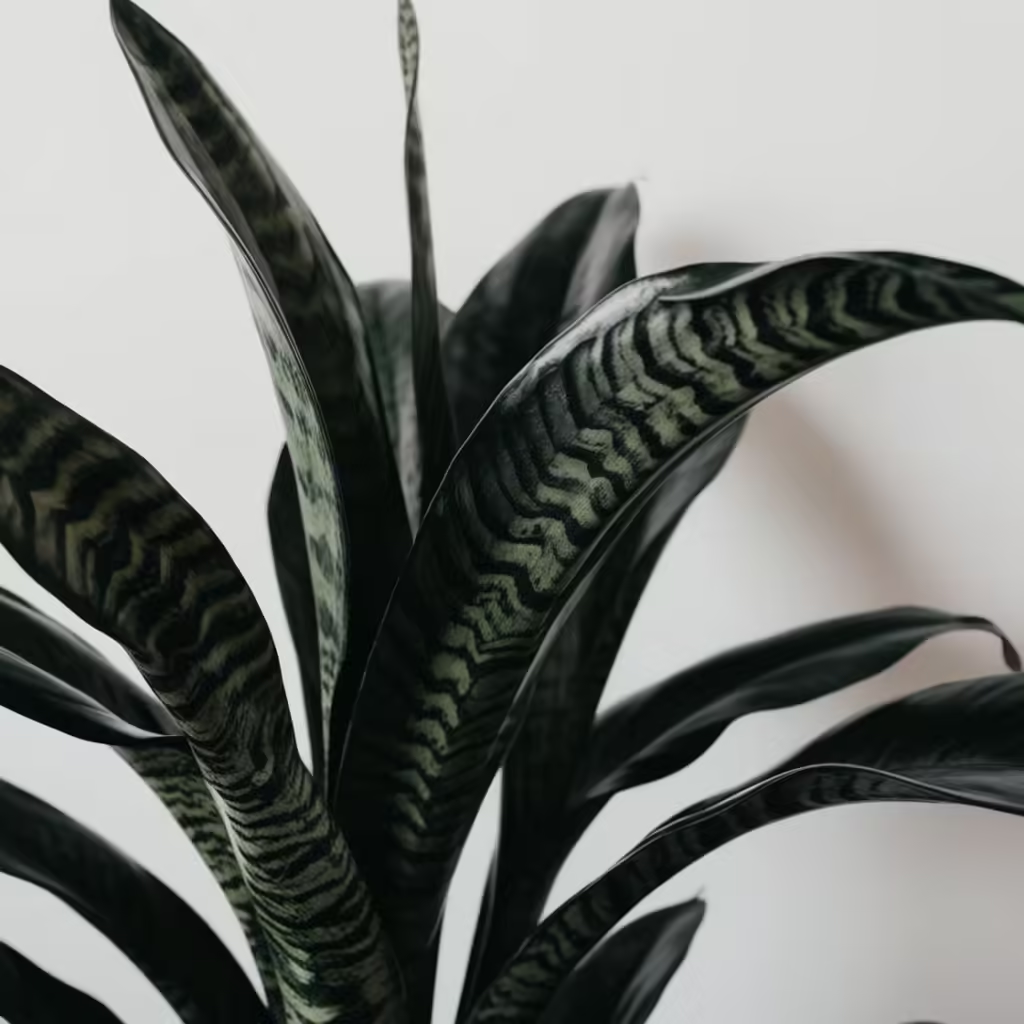
The Black Coral Snake Plant enchants with its sleek, upright foliage in shades of deep green to nearly black, adding a touch of elegance to any space.
This hardy plant, native to West Africa, is renowned for its air-purifying properties and tolerance to low light conditions. It thrives in a variety of light levels, from low to bright indirect light, making it adaptable to different indoor environments.
When it comes to fertilizing, the Black Coral Snake Plant requires minimal supplementation. Apply fertilizer sparingly with a balanced liquid fertilizer every six months to maintain its vigor without risking over-fertilization, which can lead to leaf burn and other issues.
22. Black Magic Ti Plant (Cordyline fruticosa ‘Black Magic’)
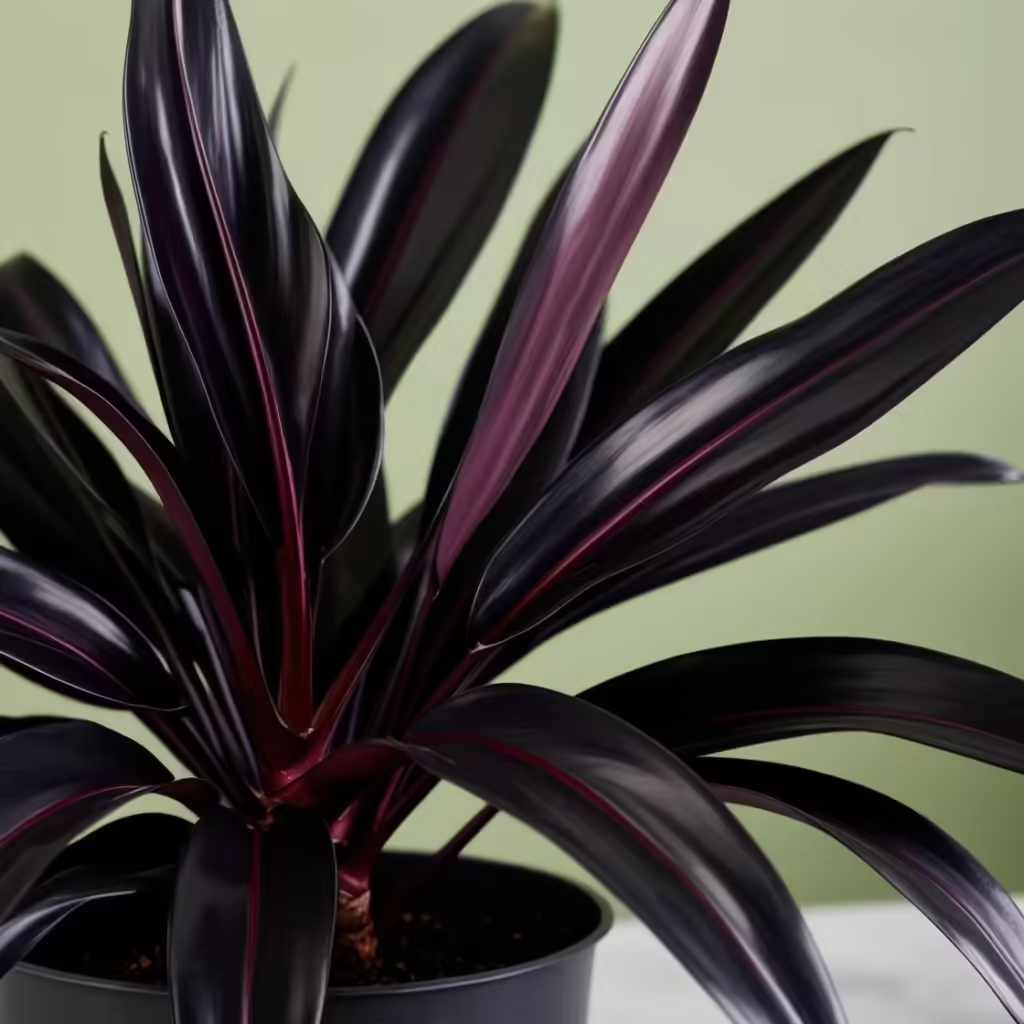
With its dramatic, deep burgundy leaves, the Black Magic Ti Plant commands attention in any indoor or outdoor setting.
Originating from tropical Southeast Asia and the Pacific Islands, this striking plant thrives in bright, indirect light and well-draining soil.
While it can tolerate some direct sunlight, too much exposure can lead to leaf scorching.
Keep the soil consistently moist, especially during the growing season, to support vigorous growth and vibrant foliage coloration.
Fertilize the Black Magic Ti Plant monthly with a balanced liquid fertilizer diluted to half-strength during the active growing months to promote lush foliage and overall plant health.
23. Black Mondo Grass (Ophiopogon planiscapus ‘Nigrescens’)
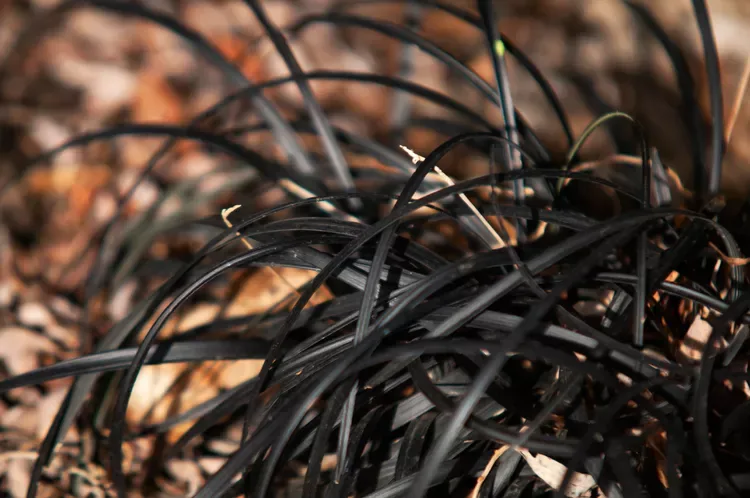
The Black Mondo Grass is a unique addition to any garden or indoor space, boasting slender, ebony-colored foliage that forms dense clumps.
Native to Japan, this ornamental grass thrives in partial to full shade and moist, well-draining soil.
While it can tolerate drier conditions once established, regular watering is essential to prevent the soil from drying out completely.
Fertilize the Black Mondo Grass in early spring with a slow-release fertilizer formulated for ornamental grasses to provide the nutrients necessary for healthy growth and vibrant foliage coloration.
Avoid over-fertilizing, as excessive nutrients can lead to weak, leggy growth and diminish the plant’s ornamental appeal.
24. Black Pagoda Lipstick Plant (Aeschynanthus radicans ‘Black Pagoda’)
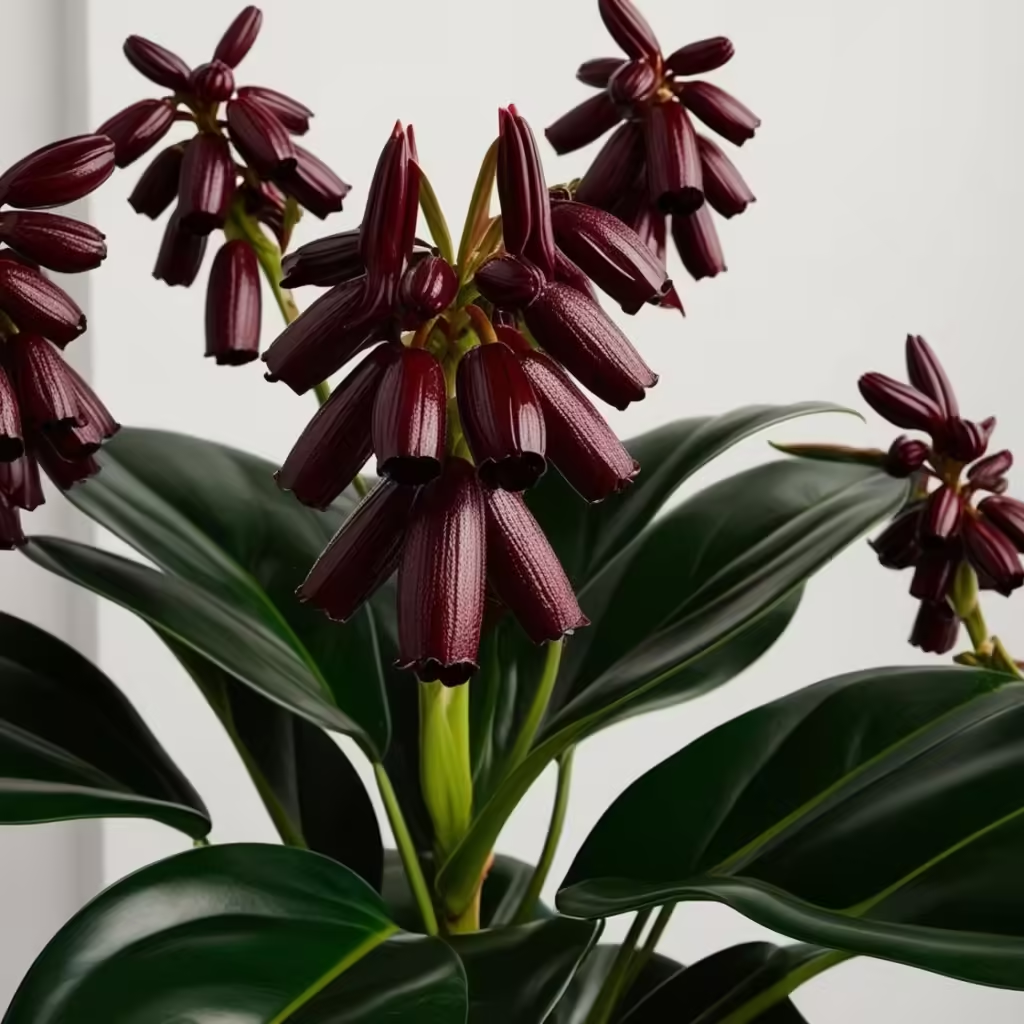
With its cascading vines adorned with dark green leaves and vibrant red blooms, the Black Pagoda Lipstick Plant adds a touch of exotic beauty to any hanging basket or container garden.
Originating from tropical regions of Southeast Asia, this evergreen perennial thrives in bright, indirect light and well-draining soil.
For best results, keep the soil consistently moist, but avoid overwatering, as soggy conditions can lead to root rot.
Fertilize the Black Pagoda Lipstick Plant bi-weekly during the growing season with a balanced liquid fertilizer diluted to half-strength to promote abundant flowering and healthy foliage.
Deadhead spent blooms regularly to encourage continuous blooming throughout the growing season.
25. Black Sapphire Spiderwort (Tradescantia spathacea ‘Black Sapphire’)
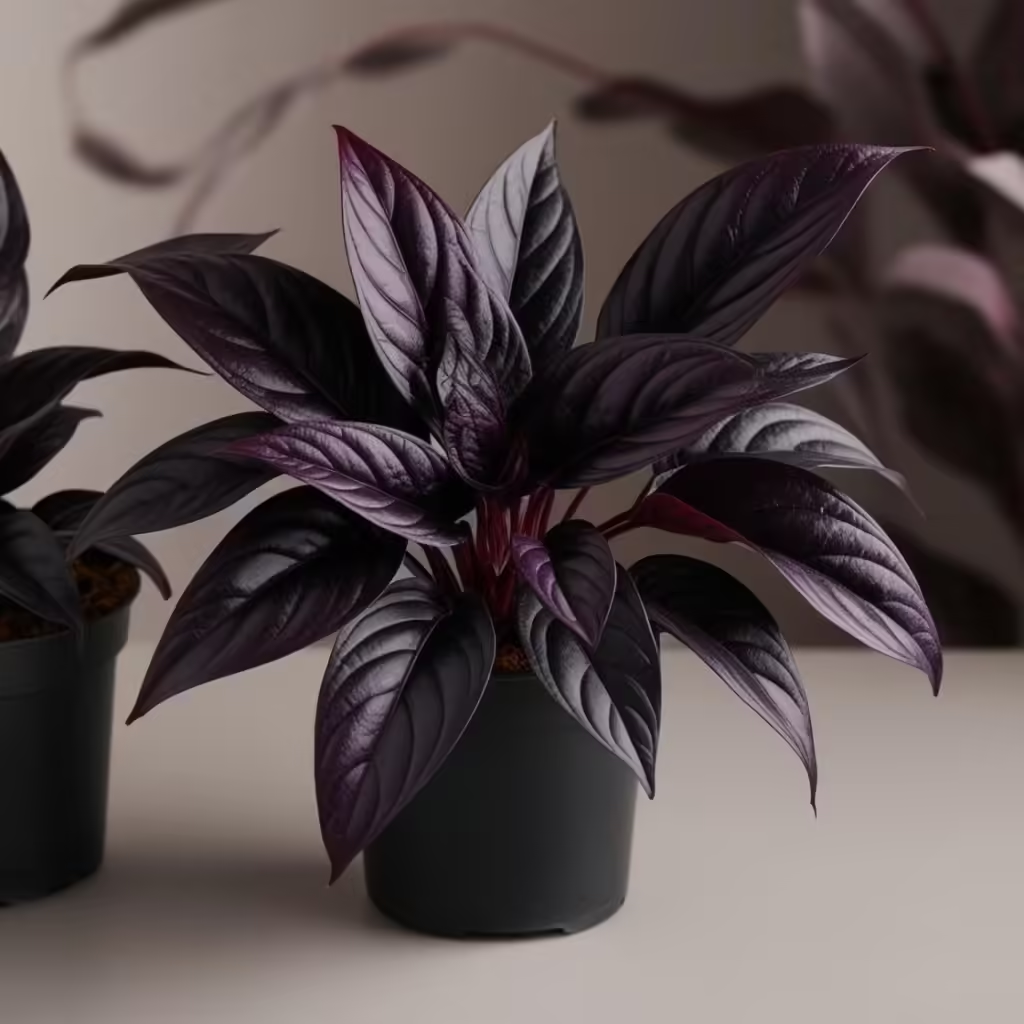
The Black Sapphire Spiderwort is a captivating black houseplant famed for its dark purple-black foliage and delicate white flowers.
Native to Central America, this low-maintenance plant thrives in bright, indirect light and well-draining soil.
Allow the soil to dry out slightly between waterings to prevent root rot, especially during the dormant winter months.
Fertilize the Black Sapphire Spiderwort monthly during the growing season with a balanced liquid fertilizer diluted to half-strength to provide essential nutrients for healthy growth and vibrant foliage coloration.
Prune back leggy growth regularly to maintain a compact, bushy appearance and encourage new growth from the base of the plant.
26. Black Cardinal Philodendron (Philodendron ‘Black Cardinal’)
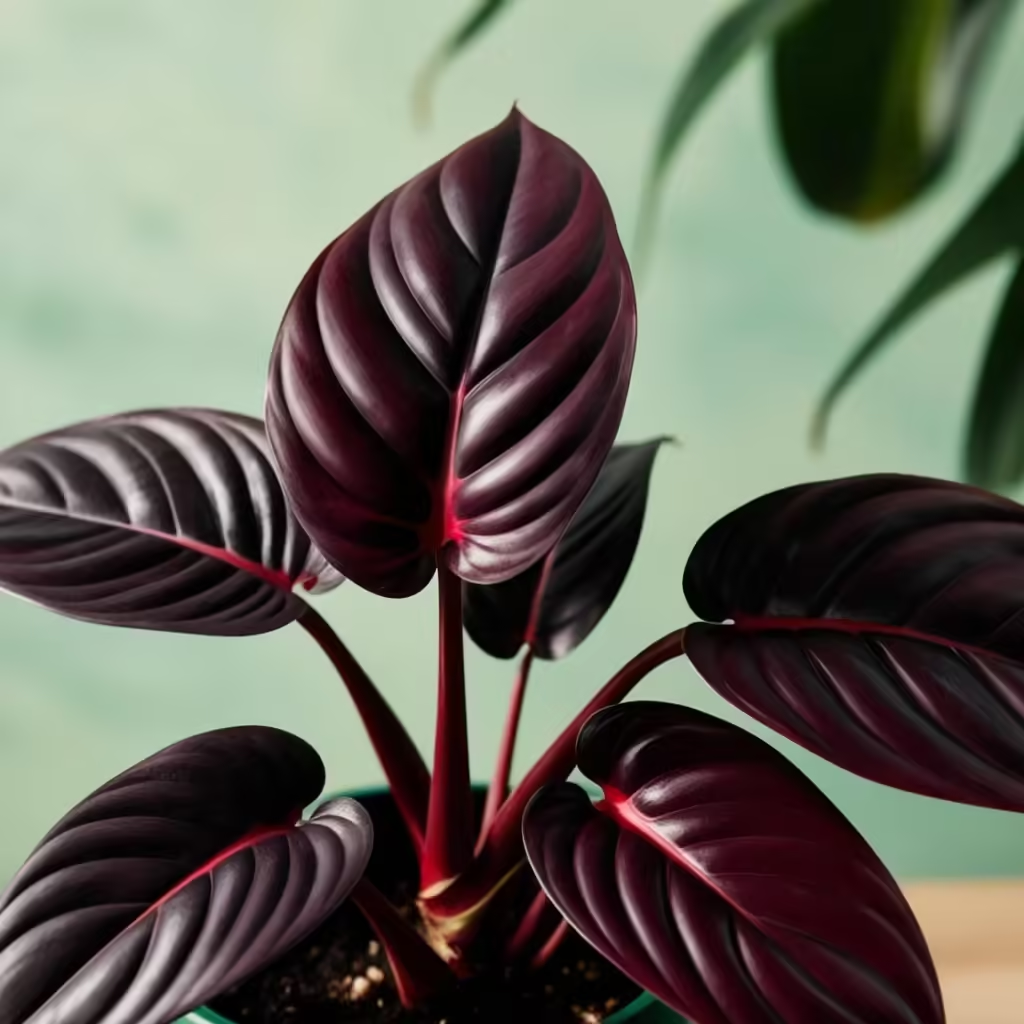
The Black Cardinal Philodendron is a stunning cultivar prized for its rich, dark foliage and elegant, heart-shaped leaves.
Native to the tropical regions of South America, this vining plant thrives in bright, indirect light and well-draining soil. Keep the soil consistently moist, but avoid overwatering to prevent root rot.
Fertilize the Black Cardinal Philodendron bi-weekly during the growing season with a balanced liquid fertilizer diluted to half-strength to support vigorous growth and vibrant foliage coloration.
Regular pruning and training will help maintain the plant’s desired shape and encourage bushy growth.
27. Black Gold Snake Plant (Sansevieria trifasciata ‘Black Gold’)
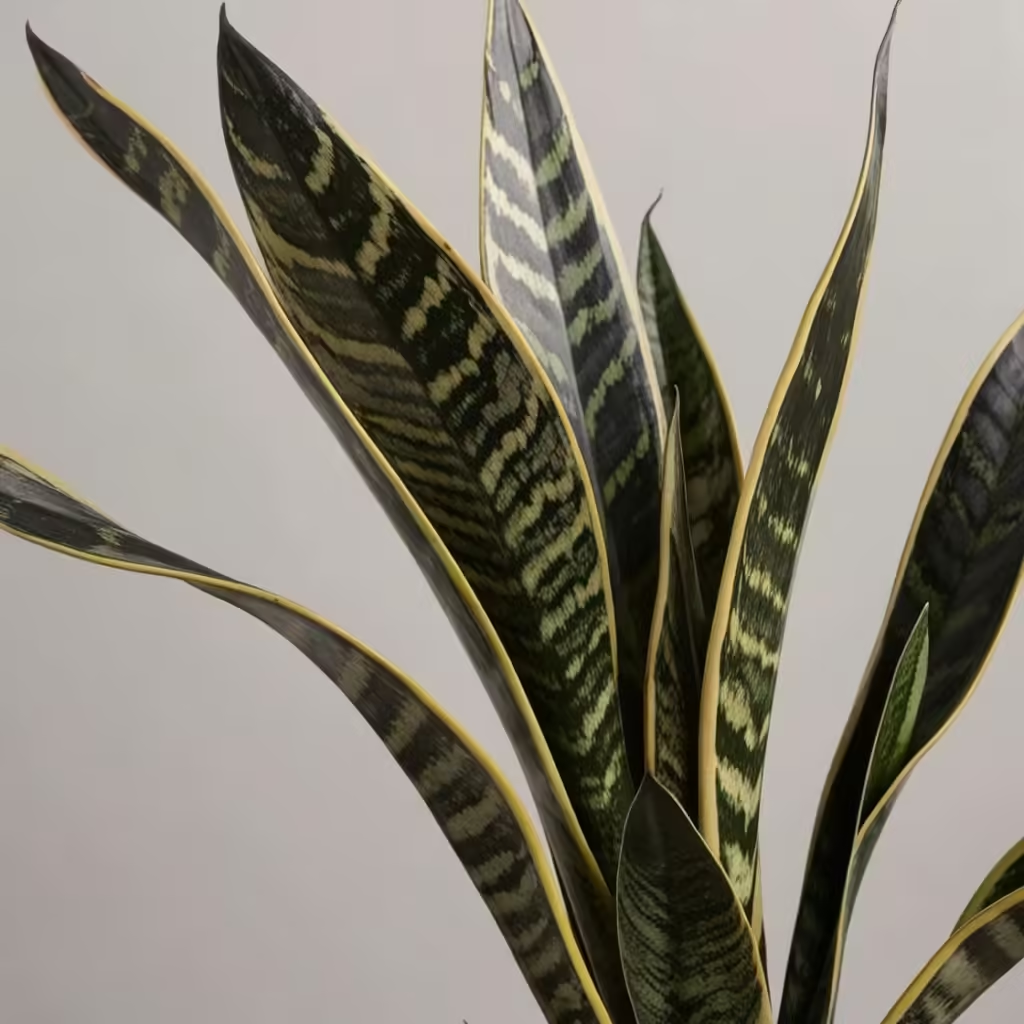
The Black Gold Snake Plant has dark green leaves adorned with golden-yellow variegation, adding a touch of elegance to any indoor space.
This plant originates from West Africa. It is a hardy plant that thrives in a wide range of light conditions, from low to bright indirect light.
Allow the soil to dry out between waterings to prevent root rot, as Snake Plants are susceptible to overwatering. Fertilize the Black Gold Snake Plant sparingly with a balanced liquid fertilizer every six months to maintain its vigor and promote vibrant foliage coloration.
Avoid over-fertilizing, as this can lead to weak, leggy growth and diminish the plant’s ornamental appeal.
28. Black Diamond Elephant Ear (Colocasia esculenta ‘Black Diamond’)
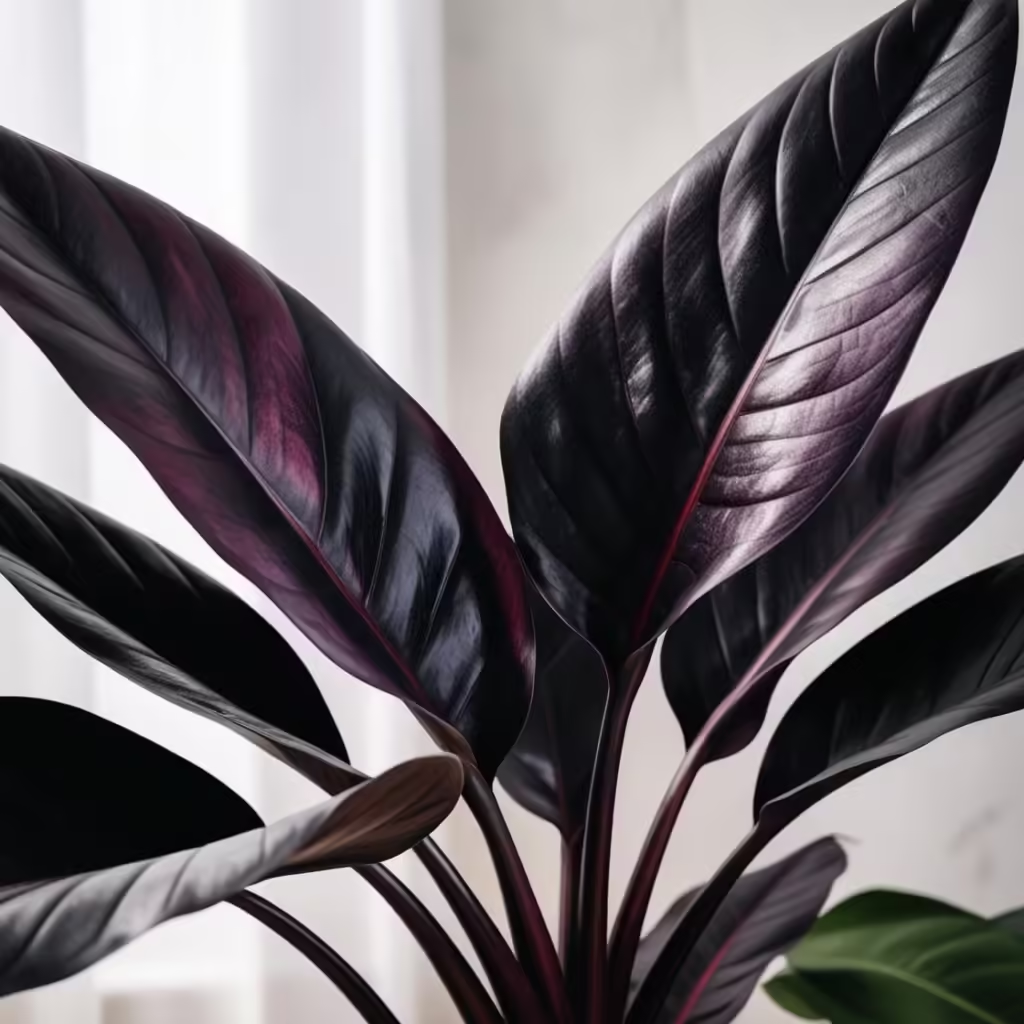
You can identify the Black Diamond Elephant Ear through its large, heart-shaped leaves with glossy, jet-black foliage.
Originating from tropical regions of Southeast Asia, this striking plant thrives in partial shade to full sun and consistently moist, well-draining soil.
Water regularly to keep the soil evenly moist, especially during the active growing season.
Fertilize the Black Diamond Elephant Ear bi-weekly with a balanced liquid fertilizer diluted to half-strength to provide essential nutrients for healthy growth and vibrant foliage coloration.
The plant also appreciated moist surroundings. Thus, mulching around the base of the plant will help retain soil moisture and suppress weed growth, while also enhancing the plant’s ornamental appeal.
Final Thoughts on Black Houseplants
Each of these black houseplants brings its unique charm and beauty to indoor and outdoor spaces, offering a captivating palette of dark foliage and striking forms.
With proper care and attention, black houseplants can thrive and enchant you with their mysterious allure and botanical elegance just like their pink or white counterparts.

